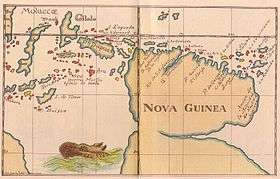Yñigo Ortiz de Retez
Yñigo Ortiz de Retez (fl. 1545) was a 16th-century Spanish maritime explorer of Basque origin, who navigated the northern coastline of the Pacific–Melanesian island of New Guinea, and is credited with bestowing the island's name ("Nueva Guinea").
Early life
Yñigo Ortiz de Retez was born in Retes de Llanteno (Alava, Spain) in a non-titled nobility family (hidalgos) in the first decade of the 16th century. The first accounts we have of him are as part of Alvarado's expedition of 1538 to take the governorship of Guatemala and Honduras. He participated in the expedition to relieve the siege of Nochistlán in 1541 during the Mixtón war, led by Alvarado. In 1542 he was appointed to the expedition of Lopez de Villalobos to the Islas de Poniente (Philippines). Upon his arrival in Mindanao on February 1543, Ortiz de Retes was promoted to Maestre de Campo.[1]
Discovery of New Guinea

After the unsuccessful attempt of Bernardo de la Torre in 1543 to make the round trip and return to Mexico, López de Villalobos commissioned Ortiz de Retez for the same mission but this time taking a more southerly route. On 16 May 1545 Ortiz de Retez, in command of the San Juan de Letran, left port in Tidore, an island which was Spain's stronghold in the Maluku Islands and going by way of the Talaud Islands and the Schoutens, reached the northern coast of New Guinea, which was coasted till the end of August when, having got to the 5°S latitude, contrary winds and currents forced a return to Tidore where he arrived on 5 October 1545. Many islands were encountered and first charted, along the northern coast of New Guinea, and in the Padaidos, Le Maires, Ninigos, Kaniets and Hermits, to some of which Spanish names were given.[2][3][4]
On 20 June 1545 at the mouth of the Mamberamo river (that was charted as San Agustin) he took possession of the land for the Spanish Crown, in the process giving the island the name by which it is known today. He called it Nueva Guinea owing to the resemblance of the local inhabitants to the peoples of the Guinea coast in West Africa.[5]
The main source for Retez's voyage is that of Garcia de Escalante Alvarado, who was part of the Villalobos expedition, and who, after his return to Spain, wrote a chronicle that he sent to Antonio de Mendoza, viceroy of New Spain.[6][7]
Ortiz de Retez was later imprisoned by the Portuguese in the Malukus along with the remaining members of Villalobos' expedition; according to Escalante, he was one of the 117 who were later repatriated by the Portuguese in 1548.
References
- ↑ González Ochoa, José María (2006). "El marino alavés Iñigo Ortiz de Retes". Revista de Estudios Marítimos del País Vasco. Museo Naval San Sebastian. 5: 680.
- ↑ Coello, Francisco (1885). La Cuestión de las Carolinas. Discursos pronunciados en la Sociedad Geográfica de Madrid por su presidente Don Francisco Coello con un mapa, notas y apuntes bibliográficos sobre los antiguos descubrimientos de los españoles en los archipielagos de la Micronesia y sus cercanias. Madrid: Imprenta Fontanet. pp. 119–122.
- ↑ Sharp, Andrew (1960). The discovery oif the Pacific Islands. Oxford: Clarendon Press. pp. 30–32.
- ↑ Brand, Donald D. (1967). Friis, Herman R., ed. The Pacific Basin. Burlington: American Geographical Society. p. 123.
- ↑ Quanchi, Max (2005). Historical Dictionary of the Discovery and Exploration of the Pacific Islands. The Scarecrow Press. p. 215. ISBN 0810853957.
- ↑ de Escalante Alvarado, Garcia. Colección de documentos inéditos relativos al descubrimiento, conquesta y organización de las antiguas posesiones españolas en América y Oceania (42 vols.1864-1884 ed.). Madrid. pp. vol 5, 117–209.
- ↑ Martinez Shaw, Carlos (1999). Relación del viaje que hizo desde Nueva España a las Islas de Poniente, despues Filipinas, Ruy López de Villalobos, de orden del Virrey de Nueva España, Don Antonio de Mendoza / García de Escalante Alvarado. Santander: Universidad de Cantabria. ISBN 84-8102-234-9.